Theo Jansen’s Remarkable Strandbeests
When Art and Science Come Together in Harmony.
Theo Jansen, a Dutch artist and engineer, has gained international acclaim for his mesmerizing kinetic sculptures, known as “Strandbeests” or “beach beasts.” These ethereal creatures, which resemble skeletal animals, are powered by the wind and traverse the sands of the Dutch coastline in a manner so lifelike that they seem to breathe with the very elements. Jansen’s work straddles the intersection of art and science, embodying the visionary spirit of both disciplines. This article explores the life of Theo Jansen, his development as an artist, the conception and evolution of his Strandbeests, the reactions to his work, the profound impact of his creations, and the lasting legacy he is leaving on the world.
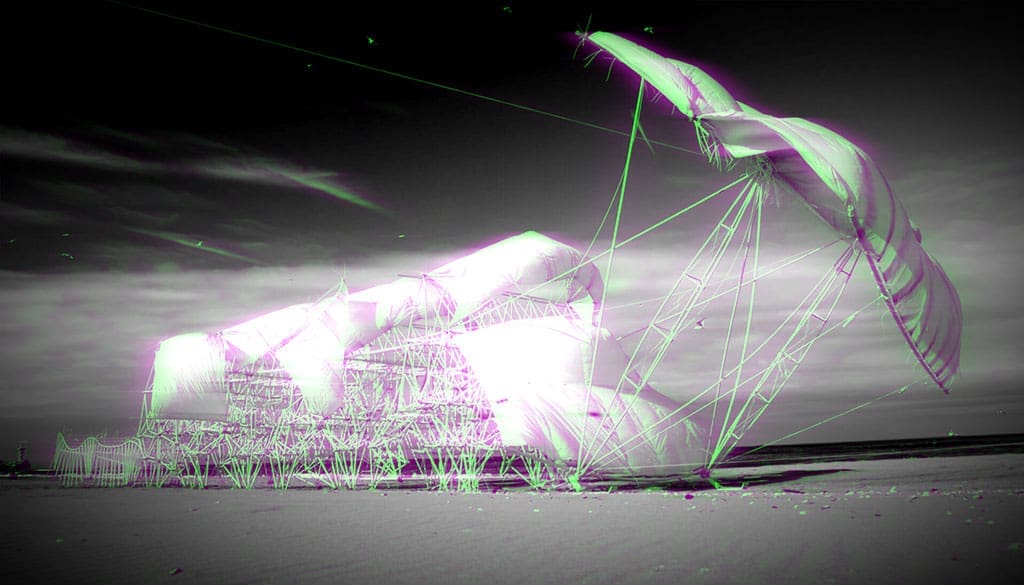
Table of Contents
Early Life and Development as an Artist
Theo Jansen was born on March 14, 1948, in Scheveningen, a seaside suburb of The Hague in the Netherlands. Growing up by the coast, Jansen developed an intimate connection with the sea and sand, elements that would later become central to his work. Jansen’s early years were marked by a deep curiosity about the natural world, which he explored through drawing and experimentation with mechanical toys. This curiosity was further nurtured by his education in physics at Delft University of Technology, where he enrolled in 1968.
Although Jansen began his academic journey with a focus on science, his passion for art soon emerged as a dominant force in his life. He was fascinated by the intersection of art and technology, and how the two could be blended to create something extraordinary. This dual interest in art and science would become the cornerstone of his career, pushing the boundaries of what art could achieve. During his university years, Jansen’s experimentation with mechanical systems and automation laid the groundwork for his later work with kinetic sculptures.
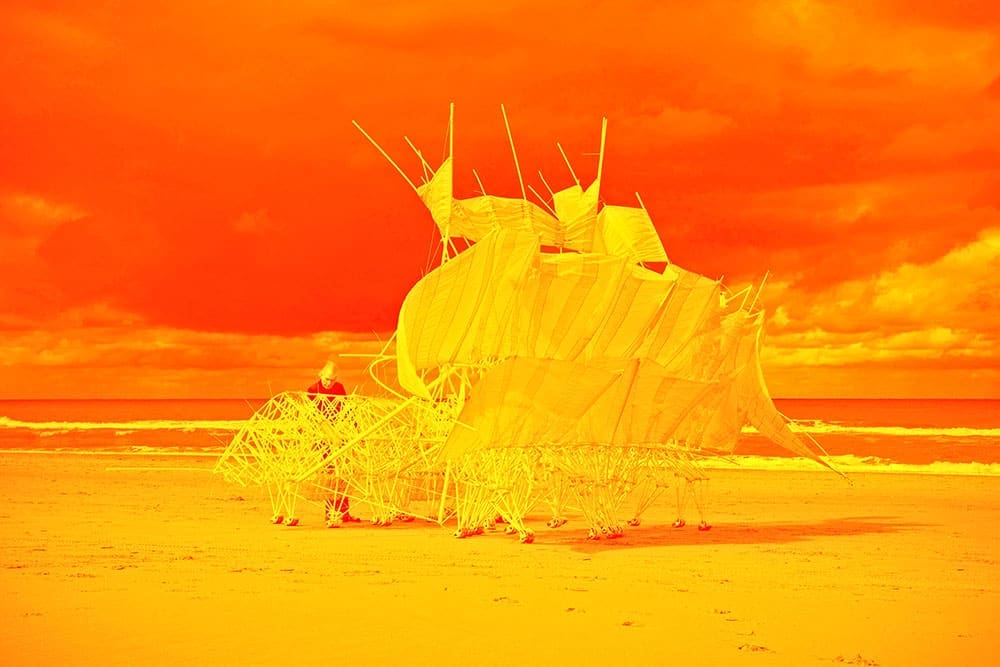
The Birth of the Strandbeests
The concept of the Strandbeests emerged in the early 1990s, following Jansen’s growing interest in artificial life and the possibilities of creating machines that could mimic the behaviours of living organisms. This interest was sparked by a project in 1990, where he wrote a newspaper column about the potential dangers of rising sea levels due to climate change. To draw attention to the issue, Jansen imagined creating large, wind-powered machines that could move sand to reinforce the dunes along the Dutch coastline, thus protecting the low-lying areas from the sea.
The Strandbeests began as an imaginative solution to an environmental problem but soon evolved into something much more profound. Jansen envisioned these creatures as a new form of life, artificial yet possessing the ability to move and adapt to their environment. Unlike traditional sculptures, which are static and confined to a specific location, Jansen’s creations were designed to interact dynamically with the world around them, responding to wind and terrain in a lifelike manner.
The first Strandbeests were simple structures made from lightweight materials such as PVC tubing, plastic bottles, and fabric. These early models, although rudimentary, demonstrated the basic principles that would guide Jansen’s work for the next several decades: the use of wind as a primary source of power, the articulation of limbs through a series of interconnected mechanical parts, and the ability to move in a way that mimicked the gait of a living creature.
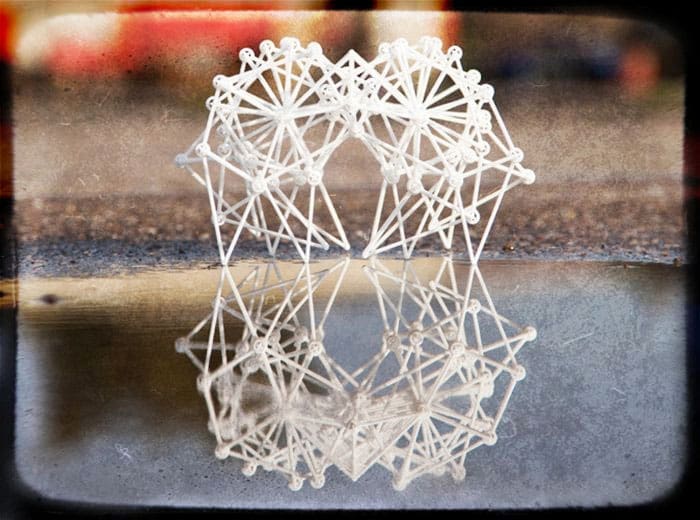
How the Strandbeests Work
The engineering behind the Strandbeests is both complex and elegant, reflecting Jansen’s deep understanding of mechanical systems and natural phenomena. The creatures are powered by the wind, which is captured by large sails or wings attached to their frames. As the wind flows through these sails, it creates rotational energy that is transferred to a series of crankshafts and linkages, which in turn move the legs of the Strandbeests in a walking motion. The design of these legs is one of Jansen’s most remarkable innovations, allowing the creatures to walk smoothly over uneven terrain, such as sand, without losing balance.
Jansen’s Strandbeests are designed with a high degree of modularity, meaning that their components can be easily assembled and disassembled. This modularity allows Jansen to experiment with different configurations and refine the creatures’ movements over time. Each new generation of Strandbeests incorporates lessons learned from previous versions, resulting in creatures that are increasingly sophisticated and capable of more complex behaviours.
*All Book Images Open a New tab to our Bookshop
**If you buy books linked to our site, we get 10% commission from Bookshop.org, whose fees support independent bookshops
One of the most fascinating aspects of the Strandbeests is their ability to sense and respond to their environment. Jansen has equipped many of his creations with simple sensory mechanisms that allow them to detect obstacles, changes in wind direction, and even the proximity of water. For example, some Strandbeests are fitted with a mechanism that triggers a change in direction when they encounter an obstacle, while others can sense when they are approaching the water’s edge and retreat to avoid being swept away by the tide.
Jansen’s creatures also possess a form of rudimentary memory, in that they are capable of storing wind energy for later use. This is achieved through a series of plastic bottles that function as air reservoirs. When the wind is strong, these bottles are pressurized, and the stored air can then be released to power the Strandbeests when the wind dies down. This feature allows the creatures to continue moving even in calm conditions, further enhancing their lifelike qualities.
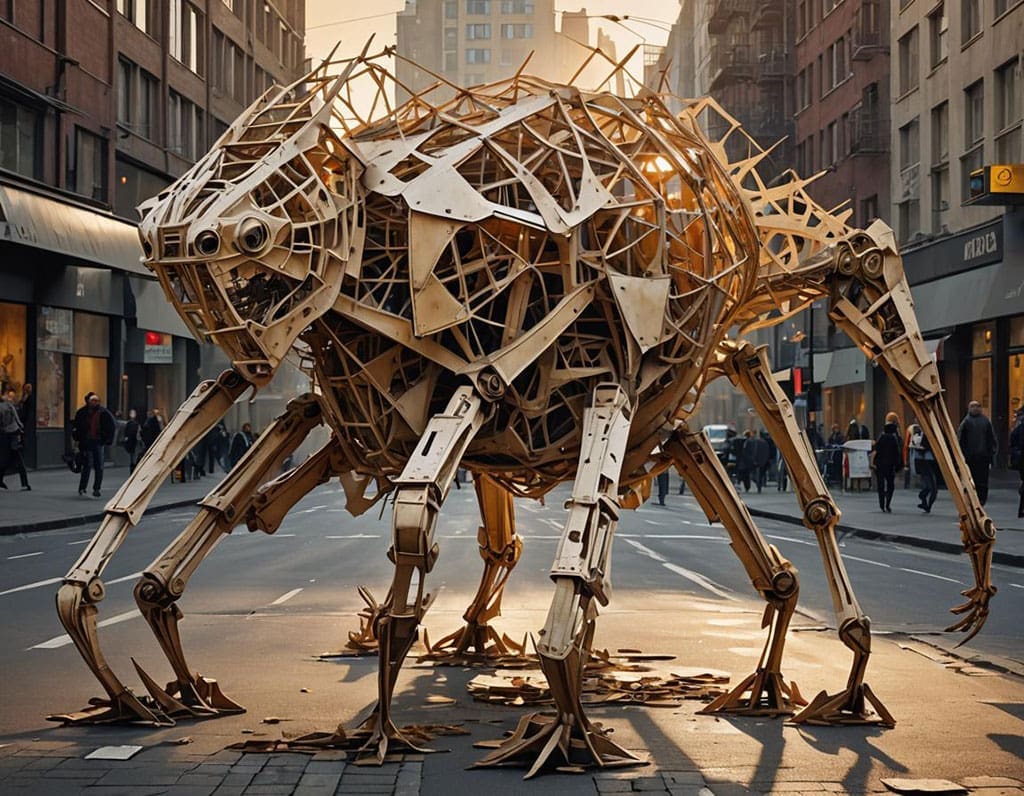
Artistic and Philosophical Implications
The Strandbeests are more than just mechanical curiosities; they are a profound statement about the relationship between art, technology, and nature. Jansen’s work challenges traditional notions of what constitutes life and raises important philosophical questions about the boundary between the animate and inanimate. By creating machines that exhibit lifelike behaviour, Jansen blurs the line between biology and engineering, suggesting that life is not a fixed category but rather a spectrum of possibilities.
Jansen has often spoken about the Strandbeests in almost spiritual terms, describing them as a new form of life that he has brought into existence. He views his role as that of a creator, guiding the evolution of these creatures through successive generations. This notion of evolution is central to Jansen’s work; he refers to the various iterations of the Strandbeests as different “species,” each with its own unique characteristics and adaptations. Over time, Jansen has deliberately allowed some species to “go extinct” while others have flourished, mirroring the process of natural selection in the biological world.
The Strandbeests also serve as a commentary on the fragility of life and the importance of adaptation in the face of environmental change. Jansen’s creatures are designed to survive and thrive in the harsh conditions of the Dutch coastline, but they are also vulnerable to the elements. The sight of these delicate, wind-driven beings struggling against the forces of nature is a powerful metaphor for the human condition, evoking both awe and empathy.
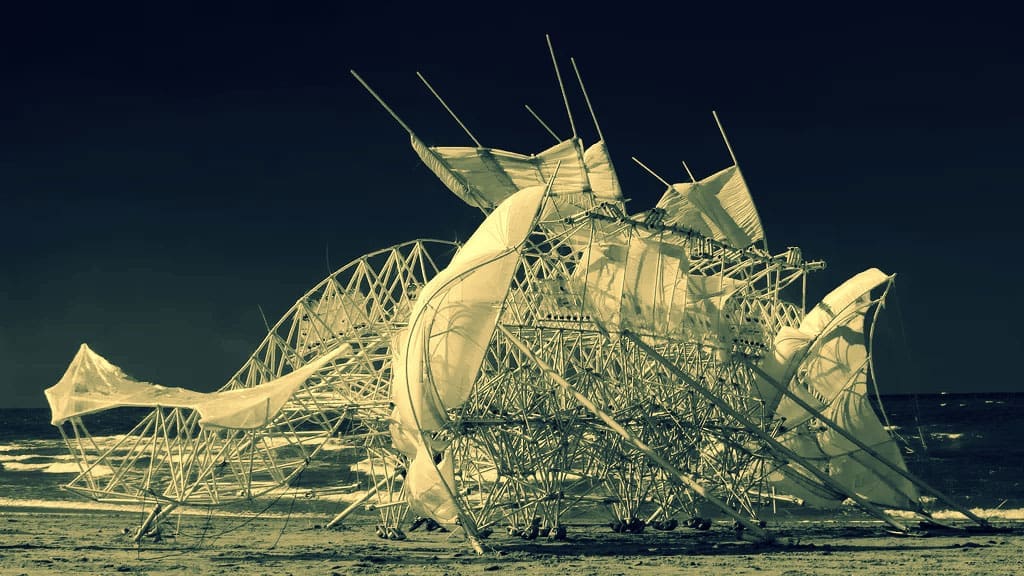
Public Reactions and Cultural Impact
Since their debut in the early 1990s, the Strandbeests have captivated audiences around the world. Exhibitions of Jansen’s work have been held in prestigious museums and galleries, including the Centre Pompidou in Paris, the Exploratorium in San Francisco, and the Tokyo National Museum. The creatures have also been featured in numerous documentaries, television programs, and online videos, further expanding their reach and influence.
The public’s reaction to the Strandbeests has been overwhelmingly positive, with viewers expressing a mix of wonder, fascination, and admiration. Many people are struck by the lifelike movements of the creatures, which seem to defy the boundaries of traditional sculpture. The Strandbeests’ ability to move and interact with their environment creates a sense of immediacy and presence that is rarely found in other forms of art.
In addition to their visual and kinetic appeal, the Strandbeests have sparked widespread interest in the underlying engineering principles that make them work. Jansen’s creations have inspired a new generation of artists, engineers, and designers who are eager to explore the possibilities of kinetic art and biomimicry. Educational programs and workshops based on the Strandbeests have been developed to teach students about mechanics, physics, and robotics, further cementing Jansen’s influence on both the art and science communities.
The Strandbeests have also had a significant impact on popular culture, appearing in advertisements, fashion campaigns, and even video games. Their otherworldly appearance and movement have made them a symbol of innovation and creativity, capturing the imagination of people from all walks of life. The Strandbeests’ popularity has also led to the production of miniature models and DIY kits, allowing enthusiasts to build their own versions of these remarkable creatures.
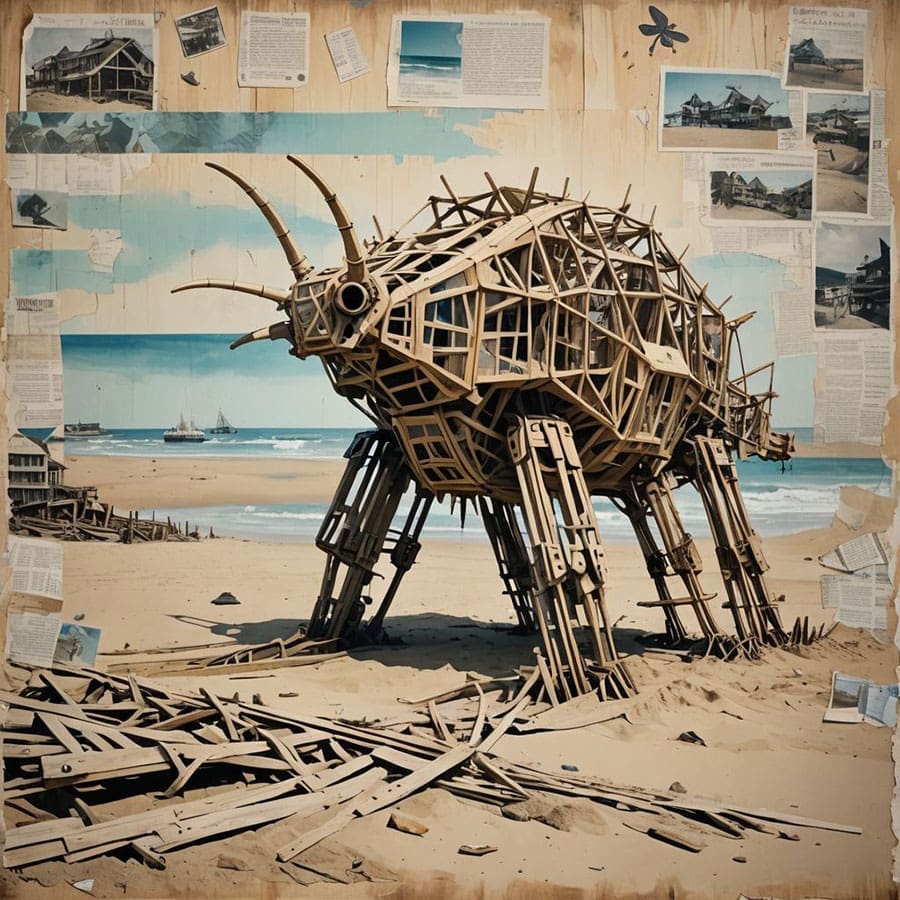
Criticisms and Challenges
While the Strandbeests have been widely praised, they have not been without their critics. Some have questioned whether Jansen’s work can truly be classified as art, given its strong reliance on engineering and mechanics. These critics argue that the Strandbeests are more akin to elaborate toys or scientific experiments than to traditional sculptures or installations.
Others have raised concerns about the environmental impact of Jansen’s work, particularly the use of plastic materials in the construction of the Strandbeests. Although Jansen has made efforts to minimize waste and reuse materials, the sheer scale of his creations has led some to question the sustainability of his practice.
Jansen himself has acknowledged these challenges and has continued to refine his approach in response to criticism. He has explored the use of alternative materials and has even experimented with biodegradable components in some of his more recent creations. However, Jansen remains committed to his original vision, emphasizing the importance of the Strandbeests as a platform for exploring the relationship between art, engineering, and nature.
By continually evolving his methods and materials, he seeks to balance innovation with sustainability, ensuring that his creations not only captivate the imagination but also contribute to a broader dialogue about environmental responsibility and the potential for art to effect positive change. Jansen’s dedication to pushing the boundaries of his work while addressing ecological concerns reflects his belief that art should engage with and respond to the world in meaningful ways, fostering both aesthetic appreciation and environmental awareness.
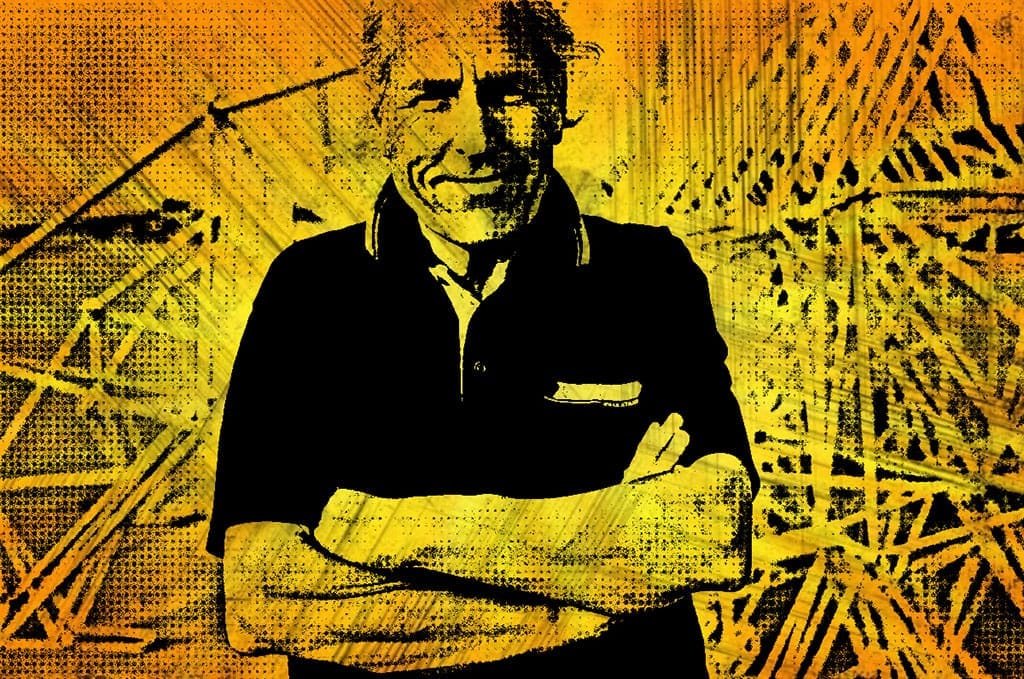
Legacy and Influence
Theo Jansen’s legacy is etched into the fabric of both art and engineering through his pioneering work with the Strandbeests. These kinetic sculptures have not only captivated audiences with their lifelike movements but have also inspired a broader dialogue about the fusion of art and science. Jansen’s innovative approach has encouraged artists and engineers alike to rethink the boundaries of their respective fields, exploring new possibilities in kinetic art and interactive installations.
The impact of Jansen’s work extends beyond the confines of traditional art spaces. His creations have become a symbol of creative ingenuity and environmental awareness, demonstrating how art can address and reflect on contemporary issues. The Strandbeests’ ability to harness wind power and interact with their environment embodies a vision of art that is dynamic and responsive, pushing the boundaries of what art can achieve.
Educational institutions have embraced Jansen’s work as a case study in the integration of artistic creativity and engineering principles. Workshops, lectures, and courses inspired by the Strandbeests offer students and enthusiasts an opportunity to engage with concepts of mechanics, robotics, and sustainable design in a hands-on, imaginative way. Jansen’s influence can be seen in the growing interest in biomimicry and the application of natural principles to technological innovation.
Furthermore, Jansen’s commitment to evolving his Strandbeests over time has set a precedent for how art can embrace change and adaptation. His approach to continuous refinement and experimentation underscores the value of iterative processes in both artistic and scientific endeavors. By treating his creations as living entities that evolve through different “species,” Jansen highlights the potential for art to contribute to a deeper understanding of life and its mechanisms.
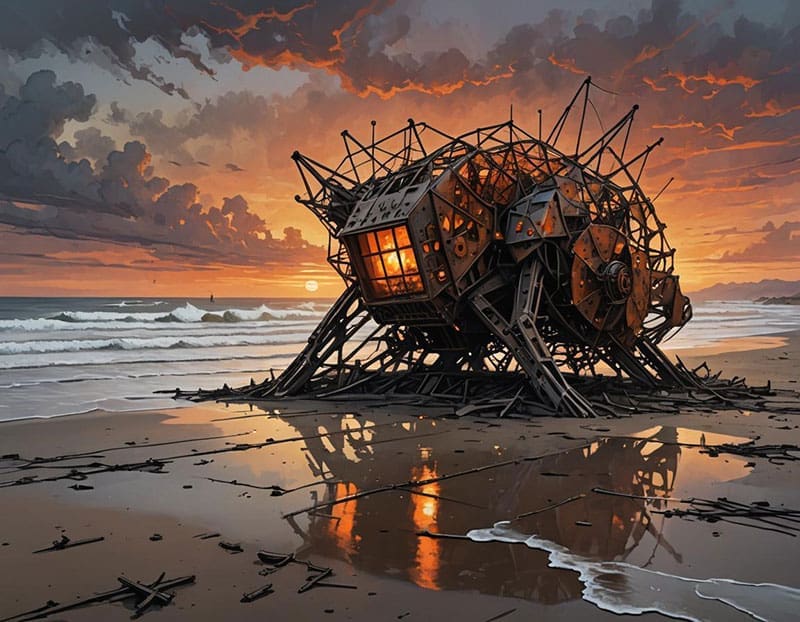
A Testament to the Power of Imagination
In the broader cultural context, Theo Jansen’s Strandbeests stand as a testament to the power of imagination and the potential of interdisciplinary collaboration. They challenge viewers to reconsider the nature of life and the role of technology in our world. Through his art, Jansen invites us to explore the intersections between nature, technology, and creativity, encouraging us to envision new possibilities for the future.
Theo Jansen’s work with the Strandbeests represents a remarkable confluence of art, engineering, and philosophy. His creations are more than mere sculptures; they are a dynamic exploration of life, movement, and the natural world. The Strandbeests not only captivate and inspire but also provoke thought and discussion about the boundaries of art and technology. Jansen’s legacy is one of innovation and imagination, leaving an indelible mark on both the art world and the field of engineering. As his Strandbeests continue to wander the sands, they remind us of the beauty and possibility that emerge when art and science come together in harmony.
*Visit and Subscribe to Theo Jansen on Instagram
**Visit The Theo Jansen website
***Visit Theo Jansen on Facebook



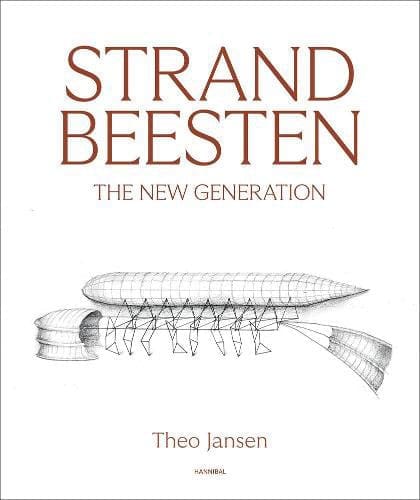













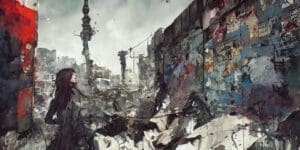




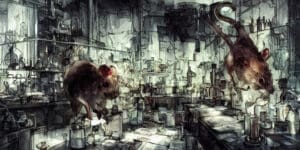



Leave a Comment